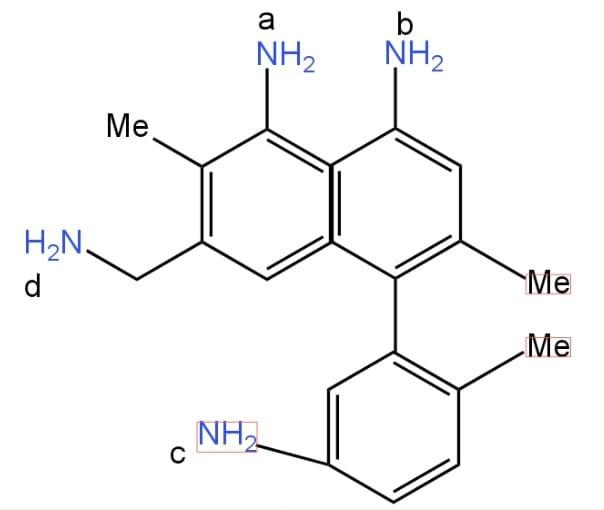
The decreasing order of the basic character of nitrogens at a, b, c, d in the given compound is:

(A) a > c > b > d
(B) d > c > b > a
(C) c > b > d > a
(D) b > c > d > a
Answer
218.4k+ views
Hint: The term ‘basic character’ means which of the compounds has a tendency to donate a lone pair of electrons or to accept a hydrogen ion.
Complete Step by Step Answer:
Among the four nitrogens present in the given compound, the nitrogen (d) is the most basic. The reason for this is that the electron pair can be easily delocalized.
Now, in the other three nitrogens (a), (b), and (c), the basic character is determined by electronic factors and$-C{{H}_{3}}$. In nitrogen (c), the electron donating $-C{{H}_{3}}$ group is in para position to $N{{H}_{2}}$. So, its basicity is higher than nitrogen (a) and (b).
The nitrogen (a) has a methyl group at ortho position to it. In this case, when the ammonium ion accepts the hydrogen, it gets out of the plane. The methyl group causes steric hindrance and thus has less tendency to donate a lone pair of electrons. As a result, nitrogen (a) has the least basic character of the given compound's nitrogens.
Correct option : (B) d > c > b > a.
Note: If an electron withdrawing group has been attached to the compound, the basic character of a compound decreases, that is, lone pair availability decreases. Alternatively, when an electron donating group is attached to a compound, its basic character, i.e. lone pair availability, increases.
Complete Step by Step Answer:
Among the four nitrogens present in the given compound, the nitrogen (d) is the most basic. The reason for this is that the electron pair can be easily delocalized.
Now, in the other three nitrogens (a), (b), and (c), the basic character is determined by electronic factors and$-C{{H}_{3}}$. In nitrogen (c), the electron donating $-C{{H}_{3}}$ group is in para position to $N{{H}_{2}}$. So, its basicity is higher than nitrogen (a) and (b).
The nitrogen (a) has a methyl group at ortho position to it. In this case, when the ammonium ion accepts the hydrogen, it gets out of the plane. The methyl group causes steric hindrance and thus has less tendency to donate a lone pair of electrons. As a result, nitrogen (a) has the least basic character of the given compound's nitrogens.
Correct option : (B) d > c > b > a.
Note: If an electron withdrawing group has been attached to the compound, the basic character of a compound decreases, that is, lone pair availability decreases. Alternatively, when an electron donating group is attached to a compound, its basic character, i.e. lone pair availability, increases.
Recently Updated Pages
Class 12 Chemistry Mock Test Series for JEE Main – Free Online Practice

Difference Between Alcohol and Phenol: Structure, Tests & Uses

Classification of Drugs in Chemistry: Types, Examples & Exam Guide

Chemical Properties of Hydrogen - Important Concepts for JEE Exam Preparation

JEE General Topics in Chemistry Important Concepts and Tips

JEE Atomic Structure and Chemical Bonding important Concepts and Tips

Trending doubts
JEE Main 2026: Application Form Open, Exam Dates, Syllabus, Eligibility & Question Papers

Derivation of Equation of Trajectory Explained for Students

Hybridisation in Chemistry – Concept, Types & Applications

Understanding the Angle of Deviation in a Prism

Understanding Collisions: Types and Examples for Students

Understanding Atomic Structure for Beginners

Other Pages
NCERT Solutions For Class 12 Chemistry Chapter 1 Solutions - 2025-26

NCERT Solutions for Class 12 Chemistry Chapter Chapter 7 Alcohol Phenol and Ether

NCERT Solutions ForClass 12 Chemistry Chapter Chapter 8 Aldehydes Ketones And Carboxylic Acids

JEE Advanced Marks vs Ranks 2025: Understanding Category-wise Qualifying Marks and Previous Year Cut-offs

Haloalkanes and Haloarenes Class 12 Chemistry Chapter 6 CBSE Notes - 2025-26

Solutions Class 12 Chemistry Chapter 1 CBSE Notes - 2025-26




